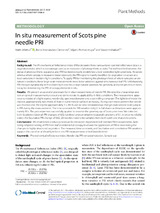Mostrar el registro sencillo del ítem
In situ measurement of Scots pine needle PRI
| dc.contributor.author | Möttus, Matti | |
| dc.contributor.author | Hernández Clemente, Rocío | |
| dc.contributor.author | Perheentupa, Viljami | |
| dc.contributor.author | Markiet, Vincent | |
| dc.date.accessioned | 2024-01-30T12:42:13Z | |
| dc.date.available | 2024-01-30T12:42:13Z | |
| dc.date.issued | 2017 | |
| dc.identifier.issn | 1746-4811 | |
| dc.identifier.uri | http://hdl.handle.net/10396/26842 | |
| dc.description.abstract | Background: The Photochemical Reflectance Index (PRI) calculated from narrow-band spectral reflectance data is a vegetation index which is increasingly used as an indicator of photosynthetic activity. The leaf-level link between the status of photosynthetic apparatus and PRI has been robustly established under controlled light conditions. However, when a whole canopy is measured instantaneously, the PRI signal is heavily modified by vegetation structure and local variations in incident light conditions. To apply PRI for monitoring the photosynthesis of whole canopies under natural conditions, these large-scale measurements need to be validated against simultaneous leaf PRI. Unfortunately, PRI changes dynamically with incident light and has a large natural variation. No generally accepted procedure exists today for determining the PRI of canopy elements in situ. Results: We present a successful procedure for in situ measurements of needle PRI. We describe, characterize and test an optical measurement protocol and demonstrate its applicability in field conditions. The measurement apparatus consisted of a light source, needle clip, spectroradiometer and a controlling computer. The light level inside the clip was approximately two-thirds of that on sunlit needle surfaces at midday. During each measurement the needle was inserted into the clip for approximately 5 s. We found no near-instantaneous changes (sub-second scale jumps) in PRI during the measurements. The time constants for PRI variation in light to full shade acclimations were approximately 10 s. The procedure was successfully applied to monitor the greening-up of Scots pine trees. We detected both facultative (diurnal) PRI changes of 0.02 (unitless) and constitutive (seasonal) variations of 0.1. In order to reliably detect the facultative PRI change of 0.02, 20 needles need to be sampled from both sunlit and shaded locations. Conclusions: We established a robust procedure for irradiance-dependent leaf (needle) PRI measurements, facilitating empirical scaling of PRI from leaf (needle) to full canopy level and the application of PRI to monitoring the changes in highly structured vegetation. The measured time constants, and facultative and constitutive PRI variations support the use of an artificial light for in situ PRI measurements at leaf (needle) level. | es_ES |
| dc.format.mimetype | application/pdf | es_ES |
| dc.language.iso | eng | es_ES |
| dc.publisher | BMC | es_ES |
| dc.rights | https://creativecommons.org/licenses/by-nc-nd/4.0/ | es_ES |
| dc.source | Plant Methods volume 13, Article number: 35 (2017) | es_ES |
| dc.subject | Photochemical reflectance index | es_ES |
| dc.subject | Needle clip | es_ES |
| dc.subject | PRI temporal variation | es_ES |
| dc.subject | Sample size | es_ES |
| dc.title | In situ measurement of Scots pine needle PRI | es_ES |
| dc.type | info:eu-repo/semantics/article | es_ES |
| dc.relation.publisherversion | https://doi.org/10.1186/s13007-017-0184-4 | es_ES |
| dc.rights.accessRights | info:eu-repo/semantics/openAccess | es_ES |

